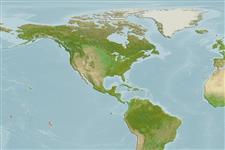Classificação / Names
Nomes comuns | Sinônimos | Catalog of Fishes(Gênero, Espécies) | ITIS | CoL | WoRMS | Cloffa
>
Eupercaria/misc (Various families in series Eupercaria) >
Labridae (Wrasses) > Xyrichtyinae
Etymology: Iniistius: Latin, in = in + Greek, istion = sail; auropunctatus: Named for the numerous tiny orange spots on the body of both males and females..
More on authors: Randall, Earle & Robertson.
Environment: milieu / climate zone / depth range / distribution range
Ecologia
marinhas; intervalo de profundidade 15 - 17 m (Ref. 39775). Tropical
Distribuição
Países | Áreas da FAO | Ecossistemas | Ocorrências | Point map | Introduções | Faunafri
Eastern Central Pacific: Marquesas Islands.
Tamanho / Peso / Idade
Maturity: Lm ? range ? - ? cm
Max length : 12.9 cm SL macho/indeterminado; (Ref. 39775); 10.3 cm SL (female)
Descrição suscinta
Morfologia | Morfometria
Espinhos dorsais (total): 9; Raios dorsais (total): 12; Espinhos anais 3; Raios anais : 12; Vértebras: 25. Body depth 2.75-3.2 in SL. A broad band of small scales extending from below eye to slightly below corner of mouth; 2 or 3 scales dorsoanteriorly on opercle. First and second dorsal spines flexible, about twice length of third spine, slightly longer than longest dorsal soft ray, and not separated from remainder of fin; space between 2nd and 3rd dorsal spines about 1.5 times greater than space between 3rd and 4th spines; membrane between 2nd and 3rd dorsal spines incised to about 1/3 length of 3rd dorsal spine. A small black spot a scale row below 8th lateral line scale (above tip of pectoral fin). Both sexes with a row of orange dots along lateral line and scattered dots below, posteriorly on body; females with a large roundish pink patch dorsally on abdomen containing oblique orange lines on scale edges, ending dorsally in orange spots; males with black lines variously under edges of 2nd to 6th lateral-line scales, sometimes extending to row above or below, and no pink patch on abdomen (Ref. 39775).
Inhabits sandy areas; quickly dives into the sand when threatened (Ref. 39775).
Ciclo de vida ou comportamento de acasalamento
Maturidade | Reprodução | Desova | Ovos | Fecundidade | Larvas
Distinct pairing during breeding (Ref. 205).
Randall, J.E., J.L. Earle and D.R. Robertson, 2002. Iniistius auropunctatus, a new razorfish (Perciformes: Labridae) from the Marquesas Islands. Cybium 26(2):93-98. (Ref. 39775)
Status na Lista Vermelha da UICN (Ref. 130435)
Ameaça para os humanos
Harmless
Uso pelos humanos
Mais informação
PaísesÁreas da FAOEcossistemasOcorrênciasIntroduçõesEstoquesEcologiaDietaItens alimentaresConsumo alimentarRação
Nomes comunsSinônimosMetabolismoPredadoresEcotoxicologiaReproduçãoMaturidadeDesovaAgregação de desovaFecundidadeOvosDesenvolvimento dos ovos
Idade/TamanhoCrescimentoPeso-comprimentoComprimento-comprimentoFrequências de comprimentoMorfometriaMorfologiaLarvasDinâmica larvalRecrutamentoAbundânciaBRUVS
ReferênciasAquaculturaPerfil para aquaculturaEstirpesGenéticaElectrophoresesHereditariedadeDoençasProcessamentoNutrientsConversão de massa
ColaboradoresFotosStamps, Coins Misc.SonsCiguateraVelocidadeTipo de nataçãoÁrea branquialOtólitosCérebrosVisão
Ferramentas
Relatórios especiais
Baixar XML
Fontes da internet
Estimates based on models
Preferred temperature (Ref.
123201): 27.4 - 28.4, mean 28 °C (based on 33 cells).
Índice de diversidade filogenética (Ref.
82804): PD
50 = 0.5000 [Uniqueness, from 0.5 = low to 2.0 = high].
Bayesian length-weight: a=0.01023 (0.00397 - 0.02640), b=3.06 (2.84 - 3.28), in cm total length, based on LWR estimates for this (Sub)family-body shape (Ref.
93245).
Nível Trófico (Ref.
69278): 3.4 ±0.5 se; based on size and trophs of closest relatives
Resiliência (Ref.
120179): Elevada, tempo mínimo de duplicação da população menor que 15 meses (Preliminary K or Fecundity.).
Fishing Vulnerability (Ref.
59153): Low vulnerability (10 of 100).
